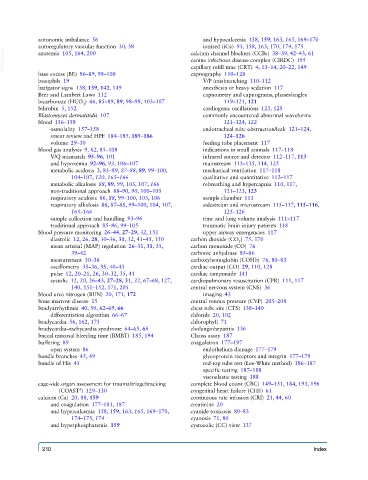Page 218 - Basic Monitoring in Canine and Feline Emergency Patients
P. 218
autonomic imbalance 56 and hypocalcemia 158, 159, 163, 165, 169–170
ionized (iCa) 93, 158, 163, 170, 174, 175
autoregulatory vascular function 30, 38 calcium channel blockers (CCBs) 38–39, 42–43, 61
VetBooks.ir canine infectious disease complex (CIRDC) 195
azotemia 105, 164, 200
capillary refill time (CRT) 4, 13–14, 20–22, 149
base excess (BE) 86–89, 98–100 capnography 110–128
basophils 19 V/P (mis)matching 110–112
bat/gator signs 138, 139, 142, 149 anesthesia or heavy sedation 117
Beer and Lambert Laws 112 capnometry and capnograms, phases/angles
bicarbonate (HCO ) 66, 85–89, 89, 98–99, 103–107 119–121, 121
3
bilirubin 5, 152 cardiogenic oscillations 123, 125
Blastomyces dermatitidis 107 commonly encountered abnormal waveforms
blood 156–158 121–124, 122
osmolality 157–158 endotracheal tube obstruction/leak 121–124,
smear review and HPF 184–185, 185–186 124–126
volume 29–30 feeding tube placement 117
blood gas analysis 9, 82, 85–108 indications in small animals 117–118
V/Q mismatch 95–96, 101 infrared source and detector 112–117, 113
and hypoxemia 92–96, 93, 106–107 mainstream 113–115, 114, 125
metabolic acidosis 3, 85–89, 87–88, 89, 99–100, mechanical ventilation 117–118
104–107, 120, 165–166 qualitative and quantitative 112–117
metabolic alkalosis 88, 89, 99, 103, 107, 166 rebreathing and hypercapnia 110, 117,
non-traditional approach 88–90, 90, 100–105 121–123, 123
respiratory acidosis 86, 88, 99–100, 103, 106 sample chamber 113
respiratory alkalosis 86, 87–88, 99–100, 104, 107, sidestream and microstream 115–117, 115–116,
165–166 125–126
sample collection and handling 93–96 time and lung volume analysis 111–117
traditional approach 85–86, 99–105 traumatic brain injury patients 118
blood pressure monitoring 26–44, 27–29, 32, 151 upper airway emergencies 117
diastolic 12, 26, 28, 30–36, 31, 32, 41–45, 150 carbon dioxide (CO ) 75, 170
2
mean arterial (MAP) regulation 26–31, 31, 35, carbon monoxide (CO) 76
39–42 carbonic anhydrase 85–86
measurement 30–36 carboxyhemoglobin (COHb) 76, 80–83
oscillometry 35–36, 35, 40–43 cardiac output (CO) 29, 110, 128
pulse 12, 20–21, 26, 30–32, 35, 41 cardiac tamponade 141
systolic 12, 20, 26–43, 27–28, 31, 32, 67–68, 127, cardiopulmonary resuscitation (CPR) 111, 117
140, 151–152, 171, 205 central nervous system (CNS) 36
blood urea nitrogen (BUN) 20, 171, 172 imaging 43
bone marrow disease 15 central venous pressure (CVP) 205–208
bradyarrhythmia 40, 50, 62–69, 66 chest tube site (CTS) 138–140
differentiation algorithm 66–67 chloride 20, 102
bradycardia 56, 162, 175 chlorophyll 71
bradycardia–tachycardia syndrome 64–65, 65 cholangiohepatitis 136
buccal mucosal bleeding time (BMBT) 185, 194 Clauss assay 187
buffering 89 coagulation 177–197
open system 86 endothelium damage 177–179
bundle branches 45, 49 glycoprotein receptors and integrin 177–179
bundle of His 45 red-top tube test (Lee-White method) 186–187
specific testing 187–188
viscoelastic testing 188
cage-side organ assessment for trauma/triage/tracking complete blood count (CBC) 149–151, 184, 193, 196
3
(COAST ) 129–130 congenital heart failure (CHF) 61
calcium (Ca) 20, 88, 159 continuous rate infusion (CRI) 21, 44, 60
and coagulation 177–181, 187 creatinine 20
and hypercalcemia 158, 159, 163, 165, 169–170, cyanide toxicosis 80–83
174–175, 174 cyanosis 71, 80
and hyperphosphatemia 159 cystocolic (CC) view 137
210 Index

